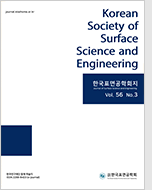
- Past Issues
- e-Submission
-

2021 Impact Factor 1.766
5-Year Impact Factor 1.674
Editorial Office
- +82-2-563-0935
- +82-2-558-2230
- submission@kssse.or.kr
- https://www.kssse.or.kr/

2021 Impact Factor 1.766
5-Year Impact Factor 1.674
The Korean Society of Surface Science and Engineering 2024;57(3):155-164. Published online: Jul, 8, 2024
DOI : 10.5695/JSSE.2024.57.3.155
Physical properties of carbon nanomaterials are dependent on their nanostructures and they are modified by diverse synthesis methods. Among them, thermal plasma method stands out for synthesizing carbon nanomaterials by controlling chemical and physical reactions through various design and operating conditions such as plasma torch type, plasma gas composition, power capacity, raw material injection rate, quenching rate, kinds of precursors, and so on. The method enables the production of carbon nanomaterials with various nanostructures and characteristics. The high-energy integration at high-temperature region thermal plasma to the precursor is possible to completely vaporize precursors, and the vaporized materials are rapidly condensed to the nanomaterials due to the rapid quenching rate by sharp temperature gradient. The synthesized nanomaterials are averagely in several nanometers to 100 nm scale. Especially, the thermal plasma was validated to synthesize low-dimensional carbon nanomaterials, carbon nanotubes and graphene, which hold immense promise for future applications.
Keywords carbon nanomaterials; synthesis; thermal plasma; nanomaterials.